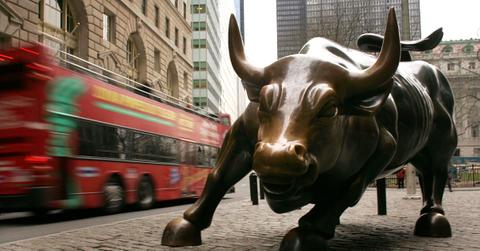Bear Market Versus Bull Market: Stock Market Trends, Explained
What’s a bear market versus a bull market? Learn about the two market trends, what they say about investor confidence, and what can cause them.
Dec. 28 2021, Published 10:51 a.m. ET

The bear market versus bull market question is getting a lot of attention in the press as stock analysts make their predictions for 2022.
Edward Jones strategist Mona Mahajan told CNBC earlier in December that the current bull market “still has some legs to go” heading into the new year.
“We still think markets can move forward, can move higher, perhaps not as high as we saw in the last three years, but in line with earnings growth and perhaps [with] a little bit more volatility,” she added.
Money expert Delyanne Barros echoes that confidence, telling NextAdvisor, “People are feeling very optimistic. People are just throwing money in the stock market because they believe that prices are going to continue to go up.”
As for cryptocurrencies, Fxpro analyst Alex Kuptsikevich told Bitcoin.com News this month that “the whole crypto sphere is in a bear market.”
What are bull markets and bear markets anyway? It all depends on which way stocks are headed.
Bull markets have stocks rising and investors confident.

Bull markets are often defined as an increase in stock prices or stock market indices of 20 percent or more over a two-month span, indicating market confidence. The common imagery is a bull thrusting stocks upward with its horns.
As NextAdvisor reports, sometimes an increase in corporate profits will spur a bull market, and sometimes an economic stimulus will. Bear markets came about during the COVID-19 pandemic and during the mortgage crisis, when “there was some sort of shock to the system, or some sort of crisis at play,” Liz Young, the head of investment strategy at SoFi, tells the site.
One notable bull market, according to Investopedia, spanned the time from the end of stagflation in 1982 to the dot-com bubble burst of 2000, during which the Dow Jones Industrial Average (DJIA) enjoyed an average annual return of 16.8 percent. The Nasdaq Composite, meanwhile, grew from 1,000 to more than 5,000 between 1995 and 2000.
Bear markets have stocks falling and investors wary.
Bear markets, on the other hand, occur when there’s a decrease in stock prices or market indices of 20 percent or more—think of a bear striking downward with its paws. During these times, investors are more likely to hold on to their money. Natural disasters, geopolitical conflict, and—yes—pandemics can cause bear markets, as can excessive risk taking, as in the case of the mortgage crisis.
In a bear market, “people are getting laid off and losing jobs and are not spending as much money,” Barros tells NextAdvisor. “People are hoarding money. People are very fearful, they’re anxious, and they’re more risk-averse. And so a lot of that feeds into the bear market.”
Between October 2007 and March 2009, for example, the Dow Jones Industrial Average dropped 54 percent, and that’s just one example of many. According to Investopedia, the DJIA saw close to three dozen bear markets between 1900 to 2018, working out to an average of one bear market every three years.
